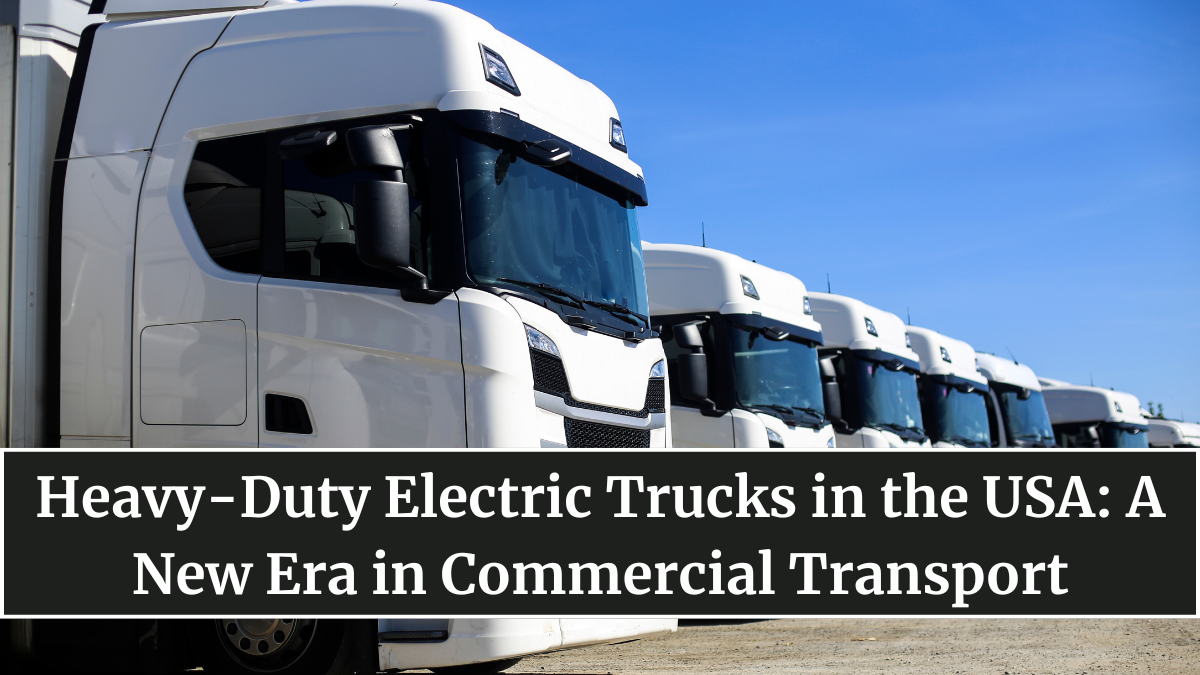America’s freight highways are about to get quieter, cleaner, and more efficient. The USA heavy-duty EV trucks and semi trucks revolution is finally here, as logistics companies, fleet operators, and manufacturers embrace the transition from diesel to electric. Once seen as impractical for long-haul routes, electric trucks are now proving that they can haul heavy loads, cut emissions, and lower operational costs — ushering in a new era in commercial transport.

Why the Shift Toward Electric Heavy-Duty Trucks?
The trucking industry contributes nearly 25% of total transportation emissions in the U.S., despite making up a small portion of total vehicles. With stricter climate policies and rising diesel prices, fleet owners are under pressure to electrify.
Several factors are accelerating the adoption:
-
Zero-emission mandates: California’s Advanced Clean Trucks (ACT) regulation requires all new truck sales to be zero-emission by 2045.
-
Lower running costs: Electric trucks cost up to 40% less per mile to operate than diesel ones.
-
Government incentives: The Inflation Reduction Act (IRA) offers tax credits up to $40,000 per truck for commercial EV buyers.
-
Corporate sustainability targets: Retailers like Walmart, Amazon, and PepsiCo are adopting EV fleets to achieve net-zero goals.
Together, these drivers are turning electric trucking from a pilot idea into a nationwide logistics movement.
Leading Players in the U.S. Heavy-Duty EV Truck Market
The U.S. is witnessing fierce competition among legacy automakers, EV startups, and logistics tech companies to dominate the emerging heavy-duty electric truck space.
| Company | Model / Platform | Range (miles) | Key Highlights |
|---|---|---|---|
| Tesla | Semi | 500 | Flagship electric semi-truck with advanced autopilot and fast-charging via Megacharger |
| Freightliner (Daimler Trucks) | eCascadia | 230–250 | Popular among fleets, backed by Daimler’s nationwide service network |
| Volvo Trucks North America | VNR Electric | 275 | Ideal for regional and short-haul operations |
| Nikola Motors | Tre BEV / Tre FCEV | 330 (BEV) / 500+ (FCEV) | Offering both battery and hydrogen options |
| Rivian / Amazon Partnership | Commercial Van & HD Prototype | 250+ | Designed for delivery operations with sustainable fleet goals |
| BYD Motors USA | 8TT Electric | 200 | Strong presence in port and municipal logistics |
Each of these manufacturers is not just selling vehicles — they’re building charging networks, battery service plans, and fleet management systems to make electrification practical for logistics companies.
Charging Infrastructure and Fleet Integration
One of the biggest challenges in electric trucking has been charging speed and network availability. To address this, federal and private programs are rapidly building megawatt charging stations across major freight corridors.
The National Electric Vehicle Infrastructure (NEVI) plan, backed by $7.5 billion in federal funding, is establishing heavy-duty charging hubs across California, Texas, Illinois, and New York.
Fleet operators are also adopting depot-based solutions:
-
PepsiCo’s Tesla Semi fleet uses on-site solar panels to power dedicated Megachargers.
-
Schneider National operates an all-electric Freightliner fleet from renewable-powered depots.
-
UPS and FedEx are integrating energy management systems to optimize route efficiency and charging cycles.
These advancements ensure that electric trucks can handle long routes without operational downtime.
Economics of Heavy-Duty EV Operations
Though the initial cost of a heavy-duty electric truck can exceed $300,000, long-term economics are favorable. According to the International Council on Clean Transportation (ICCT), lifetime costs can be 20–25% lower than diesel trucks due to:
-
Reduced fuel expenses.
-
Minimal maintenance — no oil changes or complex transmissions.
-
Regenerative braking extending component life.
-
Incentives covering up to 30% of purchase price.
Moreover, improved battery density (up to 600 Wh/kg in new models) is allowing trucks to travel longer distances between charges — a game changer for logistics viability.
The Environmental and Social Impact
Heavy-duty EVs are not only cost-effective but also transformative for urban air quality. A single Class 8 electric truck can eliminate up to 100 metric tons of CO₂ emissions per year, while drastically reducing noise pollution in city delivery zones.
This transition also supports domestic energy independence, reducing America’s reliance on imported fossil fuels. Many fleet operators are pairing their trucks with renewable energy sources like solar depots, creating net-zero logistics chains from production to delivery.
Challenges Ahead
Despite rapid progress, widespread deployment faces several challenges:
-
Limited charging infrastructure for long-haul routes.
-
Battery degradation under extreme load and temperature conditions.
-
High upfront costs for small and mid-sized fleet operators.
-
Driver retraining for handling high-voltage systems and software interfaces.
However, industry collaborations between OEMs, utilities, and logistics providers are steadily addressing these pain points through shared technology, financing, and service ecosystems.
The Road Ahead: Electrifying America’s Freight Future
By 2035, experts predict that one in three new heavy-duty trucks sold in the U.S. will be electric or hydrogen-powered. With rapid advancements in solid-state batteries, V2G (Vehicle-to-Grid) systems, and renewable charging infrastructure, the American trucking industry is poised for a cleaner, smarter, and more resilient future.
Electric heavy-duty trucks aren’t just vehicles — they’re a symbol of industrial evolution. As they begin to dominate highways and distribution networks, they represent a shift toward sustainable logistics that doesn’t compromise on performance or profitability.
FAQs
Which electric truck leads the U.S. market?
The Tesla Semi and Freightliner eCascadia are currently leading the charge in the heavy-duty electric truck segment.
What range do heavy-duty EV trucks offer?
Most new models offer 200–500 miles per charge, depending on load and terrain, with fast-charging options now improving uptime.
Are there government incentives for electric trucks in the U.S.?
Yes. Under the Inflation Reduction Act, commercial EV buyers can receive tax credits up to $40,000 per vehicle.
Can electric trucks handle long-haul routes?
Yes. With megawatt charging and improved battery density, long-haul electric trucking is becoming increasingly viable.
What’s the future outlook for heavy-duty EVs in the U.S.?
By 2035, electric and hydrogen trucks are expected to dominate new sales, making freight transport significantly cleaner and cheaper.
Click here to know more.
